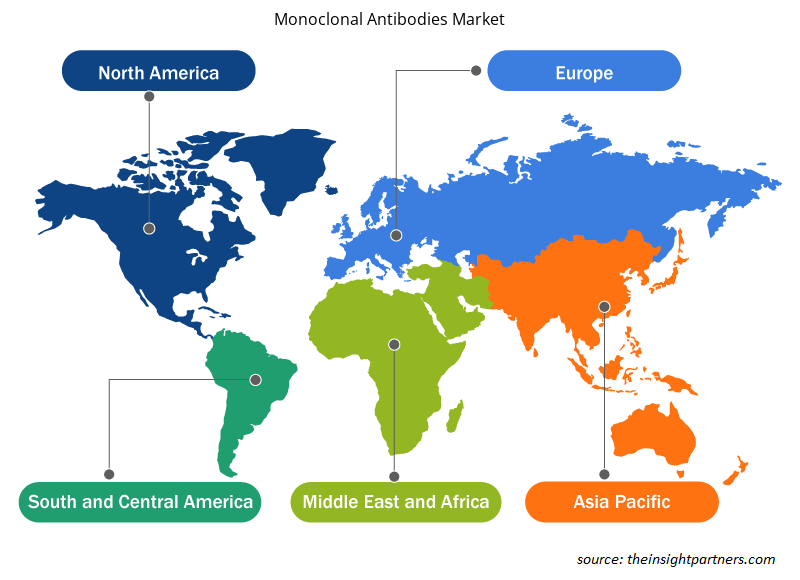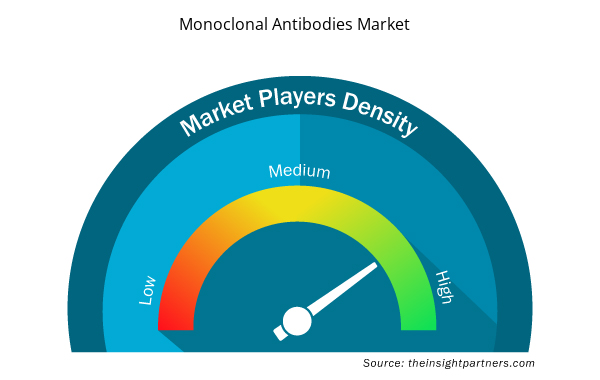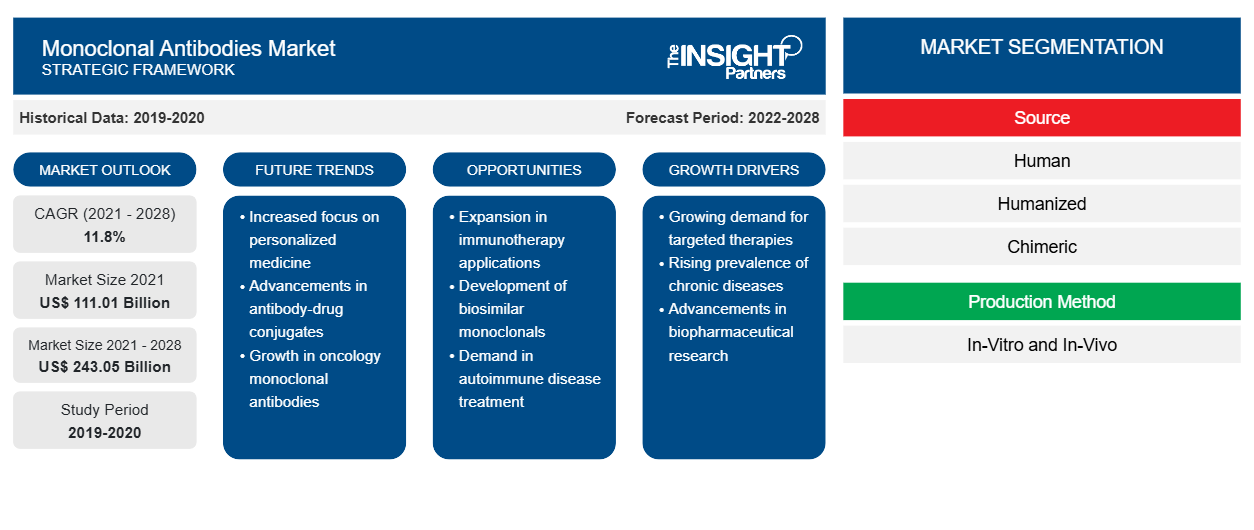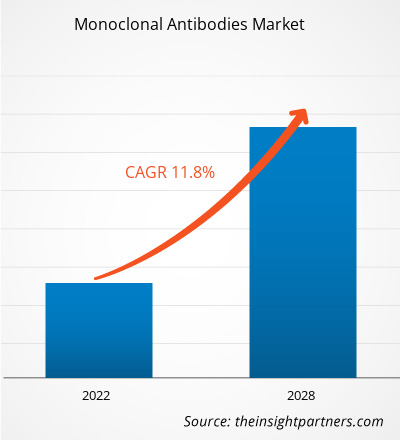Se proyecta que el mercado de anticuerpos monoclonales alcance los 243.050 millones de dólares en 2028, desde los 111.010 millones de dólares en 2021; se espera que crezca a una CAGR del 11,8% entre 2021 y 2028.
La creciente prevalencia del cáncer y otras enfermedades crónicas, y un tremendo aumento de los casos de COVID-19 en varias regiones son los factores clave que impulsan el crecimiento del mercado. Según el Fondo Mundial para la Investigación del Cáncer y el Instituto Americano del Cáncer, en 2020 se registraron aproximadamente 18,1 millones de casos de cáncer, incluidos 9,3 millones de casos en hombres y 8,8 millones de casos en mujeres. El uso de anticuerpos monoclonales en el tratamiento de varios tipos de cáncer aún se encuentra en ensayos de fase 2 y fase 3.
Es probable que América del Norte continúe dominando el mercado de anticuerpos monoclonales durante el período 2021-2028. Estados Unidos tiene la mayor participación del mercado en esta región y se espera que siga siendo un accionista dominante en el mercado durante el período de pronóstico. Según las estadísticas publicadas por Globocan en 2020, se diagnosticaron ~1.806.590 nuevos casos de cáncer en Estados Unidos y ~606.520 personas murieron debido a esta enfermedad. Según un informe del Departamento de Comercio de Estados Unidos, su Instituto Nacional de Normas y Tecnología (NIST) anunció la financiación de 153 millones de dólares al Instituto Nacional de Innovación en la Fabricación de Productos Biofarmacéuticos. Además, la FDA ha estado brindando apoyo para el desarrollo de anticuerpos monoclonales durante la prevalencia de COVID-19.
Personalice este informe según sus necesidades
Obtendrá personalización en cualquier informe, sin cargo, incluidas partes de este informe o análisis a nivel de país, paquete de datos de Excel, así como también grandes ofertas y descuentos para empresas emergentes y universidades.
- Obtenga las principales tendencias clave del mercado de este informe.Esta muestra GRATUITA incluirá análisis de datos, desde tendencias del mercado hasta estimaciones y pronósticos.
Perspectivas del mercado
El aumento significativo de la prevalencia del cáncer y otras enfermedades crónicas impulsa el crecimiento del mercado
Según el informe de la Sociedad Estadounidense del Cáncer, en enero de 2019, en Estados Unidos residían aproximadamente 16,9 millones de personas con antecedentes de cáncer. Se estima que, para enero de 2030, la población de supervivientes de cáncer aumentará a 22,1 millones debido únicamente al crecimiento y envejecimiento de la población. Por lo tanto, con la creciente prevalencia del cáncer y otras enfermedades crónicas, también ha aumentado la demanda de productos biológicos, como los anticuerpos monoclonales (mAB). Al ser componentes principales de muchos regímenes terapéuticos y tratamientos rentables, los productos biológicos desempeñan un papel clave en el tratamiento del cáncer.
Perspectivas basadas en fuentes
Según la fuente, el mercado de anticuerpos monoclonales se segmenta en murino, quimérico, humano y humanizado. Se estima que el segmento humano representará la mayor participación de mercado durante 2021-2028. El crecimiento del mercado de este segmento se atribuye al aumento debido a la integración de anticuerpos monoclonales humanos para el tratamiento de varios tipos de enfermedades infecciosas . Por ejemplo, Regeneron lanzó el cóctel de anticuerpos casirivimab e imdevimab aprobado por la FDA para su uso en COVID-19. El medicamento ha recibido la Autorización de Uso de Emergencia (EUA) de la FDA. Se utiliza para el tratamiento de COVID-19 leve a moderado en adultos, así como en pacientes pediátricos de al menos 12 años de edad y que pesen al menos 40 kg. Además, un aumento en su uso en diversas enfermedades crónicas y el empleo de tecnología avanzada de ingeniería genética se encuentran entre los factores importantes que impulsan el crecimiento del segmento de mercado.
Perspectivas basadas en indicaciones
Según la indicación, cáncer, enfermedades autoinmunes, enfermedades inflamatorias , enfermedades infecciosas, enfermedades microbianas y otras. El segmento del cáncer dominaría el mercado en los próximos años. Los avances relacionados con la aplicación terapéutica de los anticuerpos monoclonales han permitido su implementación exitosa en los tratamientos de varios tipos de cáncer, como el cáncer de mama, el cáncer de pulmón y el cáncer de colon. Los medicamentos basados en estos anticuerpos ayudan a marcar las células cancerosas, desencadenar la destrucción de la membrana celular, bloquear los inhibidores del sistema inmunológico, etc. La FDA, en junio de 2020, aprobó dos medicamentos: olaparib y rucaparib para el tratamiento del cáncer de próstata. El medicamento es especialmente eficaz entre los hombres con afecciones de cáncer de próstata que se han propagado o hecho metástasis y han dejado de responder a los tratamientos hormonales estándar, es decir, la enfermedad resistente a la castración.
Información basada en el usuario final
Por usuario final, el mercado de anticuerpos monoclonales se segmenta en hospitales, institutos de investigación y otros. El segmento hospitalario posee la mayor participación de mercado debido a la creciente adopción de los anticuerpos monoclonales como línea de tratamiento preferida, especialmente para el tratamiento del cáncer.
Las empresas que operan en el mercado de anticuerpos monoclonales adoptan la estrategia de innovación de productos para satisfacer las cambiantes demandas de los clientes en todo el mundo, lo que también les permite mantener su marca en el mercado global.
Perspectivas regionales del mercado de anticuerpos monoclonales
Los analistas de Insight Partners explicaron en detalle las tendencias y los factores regionales que influyen en el mercado de anticuerpos monoclonales durante el período de pronóstico. Esta sección también analiza los segmentos y la geografía del mercado de anticuerpos monoclonales en América del Norte, Europa, Asia Pacífico, Oriente Medio y África, y América del Sur y Central.

- Obtenga datos regionales específicos para el mercado de anticuerpos monoclonales
Alcance del informe sobre el mercado de anticuerpos monoclonales
| Atributo del informe | Detalles |
|---|---|
| Tamaño del mercado en 2021 | US$ 111.01 mil millones |
| Tamaño del mercado en 2028 | US$ 243.05 mil millones |
| CAGR global (2021-2028) | 11,8% |
| Datos históricos | 2019-2020 |
| Período de pronóstico | 2022-2028 |
| Segmentos cubiertos | Por fuente
|
| Regiones y países cubiertos | América del norte
|
| Líderes del mercado y perfiles de empresas clave |
|
Densidad de actores del mercado de anticuerpos monoclonales: comprensión de su impacto en la dinámica empresarial
El mercado de anticuerpos monoclonales está creciendo rápidamente, impulsado por la creciente demanda de los usuarios finales debido a factores como la evolución de las preferencias de los consumidores, los avances tecnológicos y una mayor conciencia de los beneficios del producto. A medida que aumenta la demanda, las empresas amplían sus ofertas, innovan para satisfacer las necesidades de los consumidores y aprovechan las tendencias emergentes, lo que impulsa aún más el crecimiento del mercado.
La densidad de actores del mercado se refiere a la distribución de las empresas o firmas que operan dentro de un mercado o industria en particular. Indica cuántos competidores (actores del mercado) están presentes en un espacio de mercado determinado en relación con su tamaño o valor total de mercado.
Las principales empresas que operan en el mercado de anticuerpos monoclonales son:
- Novartis AG
- Pfizer Inc.
- GlaxoSmithKline plc
- Amgen, Inc
- Compañía Daiichi Sankyo, Limitada
Descargo de responsabilidad : Las empresas enumeradas anteriormente no están clasificadas en ningún orden particular.

- Obtenga una descripción general de los principales actores clave del mercado de anticuerpos monoclonales
Segmentación del mercado de anticuerpos monoclonales
Según la fuente, el mercado de anticuerpos monoclonales se segmenta en humano, humanizado, quimérico y murino. Por método de producción, el mercado se segmenta en in vitro e in vivo. El mercado de anticuerpos monoclonales, por indicación, se segmenta además en cáncer, enfermedades autoinmunes, enfermedades infecciosas, enfermedades inflamatorias, enfermedades microbianas y otras. Por aplicación, el mercado se subsegmenta en aplicaciones terapéuticas, aplicaciones de diagnóstico y aplicaciones de investigación. Además, según el usuario final, el mercado se segmenta en hospitales, otros e institutos de investigación.
Mercado de anticuerpos monoclonales por geografía
- América del norte
- A NOSOTROS
- Canadá
- México
- Europa
- Francia
- Alemania
- Italia
- Reino Unido
- España
- Resto de Europa
- Asia Pacífico (APAC)
- Porcelana
- India
- Corea del Sur
- Japón
- Australia
- Resto de APAC
- Oriente Medio y África (MEA)
- Sudáfrica
- Arabia Saudita
- Emiratos Árabes Unidos
- Resto de MEA
- América del Sur y Central (SCAM)
- Brasil
- Argentina
- Resto de estafa
Perfiles de empresas
- Novartis AG
- Pfizer Inc.
- GlaxoSmithKline plc
- Amgen, Inc
- Compañía Daiichi Sankyo, Limitada
- F. Hoffmann-La Roche AG
- AstraZeneca
- Elli Lily y compañía
- Bayer AG
- Compañía Bristol-Myers Squibb
- Análisis histórico (2 años), año base, pronóstico (7 años) con CAGR
- Análisis PEST y FODA
- Tamaño del mercado Valor/volumen: global, regional, nacional
- Industria y panorama competitivo
- Conjunto de datos de Excel



Report Coverage
Revenue forecast, Company Analysis, Industry landscape, Growth factors, and Trends

Segment Covered
This text is related
to segments covered.

Regional Scope
North America, Europe, Asia Pacific, Middle East & Africa, South & Central America

Country Scope
This text is related
to country scope.
Preguntas frecuentes
Significant rise in the cancer and chronic diseases is one of the most significant factors responsible for the overall market growth.
Based on source, human segment took the forefront lead in the worldwide market by accounting largest share in 2020 and is expected to continue to do so till the forecast period.
Food and Drug Administration (FDA) defines monoclonal antibodies as immunoglobulin molecules that are secreted from a population of identical cells. They are homogenous in structure and binding specificity. These are used as multifunctional components for the immune system. They facilitate numerous cellular and humoral reactions to a variety of antigens, which include host and foreign substances.
The in vitro segment dominated the global monoclonal antibodies market and accounted for the largest revenue of 75,044.50 Mn in 2021.
Global monoclonal antibodies market is segmented by region into North America, Europe, Asia Pacific, Middle East & Africa, and South & Central America. In North America, the U.S. is the largest market for monoclonal antibodies market. The US is estimated to hold the largest share in the monoclonal antibodies market during the forecast period. The presence of top players and favorable regulations related to product approvals coupled with commercializing new products are the contributing factors for the regional growth. Additionally, the increasing number of R&D activities is the key factor responsible for the Asia-Pacific regional growth for monoclonal antibodies accounting fastest growth of the region during the coming years.
Novartis AG, Pfizer, Inc., GlaxoSmithKline Plc, Amgen, Inc., Daiichi Sankyo Company, Limited, F.Hoffmann-La Roche AG, AstraZeneca, Elli Lilly and Company, Bayer AG, Bristol-Myers Squibb Company are among the leading companies operating in the global monoclonal antibodies market
Trends and growth analysis reports related to Life Sciences : READ MORE..
The List of Companies - Monoclonal Antibody Market
- Novartis AG
- Pfizer Inc.
- GlaxoSmithKline plc
- Amgen, Inc
- Daiichi Sankyo Company, Limited
- F. Hoffmann-La Roche AG
- AstraZeneca
- Elli Lilly and Company
- Bayer AG
- Bristol-Myers Squibb Company
The Insight Partners performs research in 4 major stages: Data Collection & Secondary Research, Primary Research, Data Analysis and Data Triangulation & Final Review.
- Data Collection and Secondary Research:
As a market research and consulting firm operating from a decade, we have published and advised several client across the globe. First step for any study will start with an assessment of currently available data and insights from existing reports. Further, historical and current market information is collected from Investor Presentations, Annual Reports, SEC Filings, etc., and other information related to company’s performance and market positioning are gathered from Paid Databases (Factiva, Hoovers, and Reuters) and various other publications available in public domain.
Several associations trade associates, technical forums, institutes, societies and organization are accessed to gain technical as well as market related insights through their publications such as research papers, blogs and press releases related to the studies are referred to get cues about the market. Further, white papers, journals, magazines, and other news articles published in last 3 years are scrutinized and analyzed to understand the current market trends.
- Primary Research:
The primarily interview analysis comprise of data obtained from industry participants interview and answers to survey questions gathered by in-house primary team.
For primary research, interviews are conducted with industry experts/CEOs/Marketing Managers/VPs/Subject Matter Experts from both demand and supply side to get a 360-degree view of the market. The primary team conducts several interviews based on the complexity of the markets to understand the various market trends and dynamics which makes research more credible and precise.
A typical research interview fulfils the following functions:
- Provides first-hand information on the market size, market trends, growth trends, competitive landscape, and outlook
- Validates and strengthens in-house secondary research findings
- Develops the analysis team’s expertise and market understanding
Primary research involves email interactions and telephone interviews for each market, category, segment, and sub-segment across geographies. The participants who typically take part in such a process include, but are not limited to:
- Industry participants: VPs, business development managers, market intelligence managers and national sales managers
- Outside experts: Valuation experts, research analysts and key opinion leaders specializing in the electronics and semiconductor industry.
Below is the breakup of our primary respondents by company, designation, and region:

Once we receive the confirmation from primary research sources or primary respondents, we finalize the base year market estimation and forecast the data as per the macroeconomic and microeconomic factors assessed during data collection.
- Data Analysis:
Once data is validated through both secondary as well as primary respondents, we finalize the market estimations by hypothesis formulation and factor analysis at regional and country level.
- Macro-Economic Factor Analysis:
We analyse macroeconomic indicators such the gross domestic product (GDP), increase in the demand for goods and services across industries, technological advancement, regional economic growth, governmental policies, the influence of COVID-19, PEST analysis, and other aspects. This analysis aids in setting benchmarks for various nations/regions and approximating market splits. Additionally, the general trend of the aforementioned components aid in determining the market's development possibilities.
- Country Level Data:
Various factors that are especially aligned to the country are taken into account to determine the market size for a certain area and country, including the presence of vendors, such as headquarters and offices, the country's GDP, demand patterns, and industry growth. To comprehend the market dynamics for the nation, a number of growth variables, inhibitors, application areas, and current market trends are researched. The aforementioned elements aid in determining the country's overall market's growth potential.
- Company Profile:
The “Table of Contents” is formulated by listing and analyzing more than 25 - 30 companies operating in the market ecosystem across geographies. However, we profile only 10 companies as a standard practice in our syndicate reports. These 10 companies comprise leading, emerging, and regional players. Nonetheless, our analysis is not restricted to the 10 listed companies, we also analyze other companies present in the market to develop a holistic view and understand the prevailing trends. The “Company Profiles” section in the report covers key facts, business description, products & services, financial information, SWOT analysis, and key developments. The financial information presented is extracted from the annual reports and official documents of the publicly listed companies. Upon collecting the information for the sections of respective companies, we verify them via various primary sources and then compile the data in respective company profiles. The company level information helps us in deriving the base number as well as in forecasting the market size.
- Developing Base Number:
Aggregation of sales statistics (2020-2022) and macro-economic factor, and other secondary and primary research insights are utilized to arrive at base number and related market shares for 2022. The data gaps are identified in this step and relevant market data is analyzed, collected from paid primary interviews or databases. On finalizing the base year market size, forecasts are developed on the basis of macro-economic, industry and market growth factors and company level analysis.
- Data Triangulation and Final Review:
The market findings and base year market size calculations are validated from supply as well as demand side. Demand side validations are based on macro-economic factor analysis and benchmarks for respective regions and countries. In case of supply side validations, revenues of major companies are estimated (in case not available) based on industry benchmark, approximate number of employees, product portfolio, and primary interviews revenues are gathered. Further revenue from target product/service segment is assessed to avoid overshooting of market statistics. In case of heavy deviations between supply and demand side values, all thes steps are repeated to achieve synchronization.
We follow an iterative model, wherein we share our research findings with Subject Matter Experts (SME’s) and Key Opinion Leaders (KOLs) until consensus view of the market is not formulated – this model negates any drastic deviation in the opinions of experts. Only validated and universally acceptable research findings are quoted in our reports.
We have important check points that we use to validate our research findings – which we call – data triangulation, where we validate the information, we generate from secondary sources with primary interviews and then we re-validate with our internal data bases and Subject matter experts. This comprehensive model enables us to deliver high quality, reliable data in shortest possible time.


 Obtenga una muestra gratuita de este informe
Obtenga una muestra gratuita de este informe